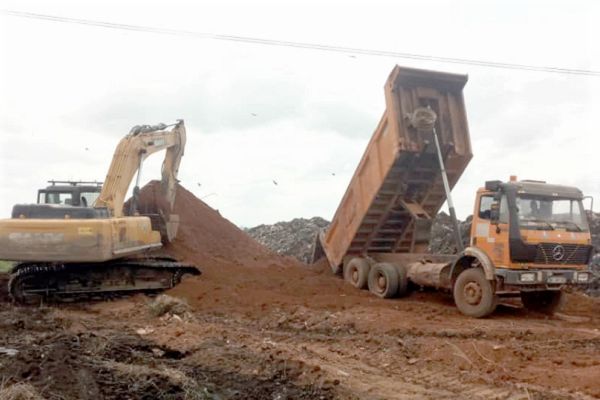
Sanitation improves in Kumasi as KMA fixes Oti landfill roads
The sanitation challenge that confronted Kumasi in recent months arose because of the continuous rains that rendered the road to the Oti landfill cell impassable.
Trucks and tricycles were unable to move in to discharge their waste, leaving piles of garbage at the sanitary sites also known as transfer sites.
Advertisement
Aware of the health and environmental implications of the problem the Kumasi Metropolitan Assembly (KMA) instituted measures to get the road fixed and today the sanitation situation in Kumasi has seen significant improvement.
The cell is a very important part of the landfill. It is a prepared place where the trash is stored within the landfill.
Oti landfill
Opened in 2004, the Oti landfill at Dompoase on the outskirts of Kumasi is a sprawling engineered facility covering an area of about 40 hectares.
It had been under the management of a private company, J. Stanley Owusu Limited, but the company had for some time now abandoned the site because it is owed millions of cedis in management fees.
During a visit by the Daily Graphic to the landfill last Saturday, construction workers using bulldozers and other earth moving equipment were putting finishing touches to the rehabilitation of access roads to the cell and create a platform where the vehicles can turn easily.
The Director of Waste Management at KMA, Mr Prosper Kotoka, said the situation would normalise immediately trucks were able to reach the cell to discharge waste.
“Once we enter the cell, it will be a done deal and the situation will come back to normal and we will just clear the backlog,” he said.
Over 60 trips of gravel material had been heaped on the stretch to the cell and two bulldozers were working day and night.
“This [ Saturday] morning they are creating the exact route into the cell.
The access road has been created up to the edge of the cell and now we want to enter the cell.
They will use laterite to direct the vehicles into the cell,” he said.
He added that what had been going on for some time now was that the waste trucks and tricycles dumped their load about 200 metres to the cell, which meant looking for additional equipment to get the waste to the final point.
Mr Kotoka said once the road entered the cell,” we will come back to clear the backlog of refuse“.
Backlog of waste cleared
There are over 400 sanitary sites in Kumasi. These are places where the solid waste is lodged temporarily before they are conveyed to the landfill
All the sanitary sites are still under the management of the KMA although some of them have fallen into the newly created municipal assemblies.
This is because the KMA has existing contracts with companies managing the sites.
Now, the backlog of waste at the sanitary sites has been cleared and according to the waste management director, “If any site is unsightly now, then it is the contractor that is not living up to expectation.”
Kumasi generates an average of 1,500 tonnes of solid waste daily out of which 1,400 is collected with the rest finding its way into drains, gutters and open places.
Mr Kotoka said the roads would have to be extended further downwards the landfill “because if we don’t make provisions now, we may came back to square one.”
Liquid waste
The assembly has also been working hard to handle the challenges with the liquid waste disposal system at the landfill.
“We realised that the ponds are being overloaded and they got choked. In an attempt to rehabilitate the ponds, we realised that we have to increase the treatment capacity.
“What is left is to do a concrete pad for the vehicles to drive onto and discharge the faecal matter.
Also, we have to dig a borehole and put a reservoir up there, mechanise it for cleaning up the place and also fix the roads around the ponds.
These are the works that we have to do to put the facility to full use,” Mr Kotoka said.
Funding challenges
All these works call for huge injection of funds and the KMA looks overstretched.
Although some investors have come in to look at how best they could partner the KMA in that regard, nothing positive had so far come out of it.
Mr Kotoka said one other problem the KMA had is that a number of assemblies were using the landfill but it was the KMA that was paying the substantial part of the management cost. What those assemblies pay takes care of just 10 per cent of operational cost.
“ We are looking at the situation where the government will intervene, pay for us for some time until we are able to agree on where the funding must come from, who should pay what, so that we will be able to manage the site effectively,” Mr Kotoka stated.



